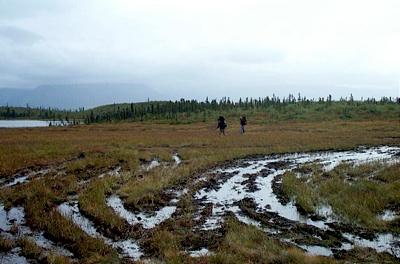A plan to repair off-road vehicle routes in Wrangell-St. Elias National Park and Preserve has been released by the National Park Service, which will need to find an estimated $4 million to have the work performed.
The Nabesna Off Road Vehicle Management Plan and Final Environmental Impact Statement was spurred by a lawsuit brought in 2006 by the National Parks Conservation Association, the Alaska Center for the Environment, and The Wilderness Society against the Park Service that questioned how it was managing recreational ORV use on nine trails in the Nabesna District of the park.
The trails have provided access for sport hunting and subsistence activities since before the park was established, according to the Park Service, which added that "summer use of ORVs on the trails has resulted in degraded trail conditions and impacts to wetlands, soils, and vegetation."
According to the NPCA, the plan will allow for ORV routes to "be improved and repaired to ensure that qualified local residents can use the trail system for subsistence activities and access to private property. Hunters and recreationists who are not local residents will continue to be able to use ORVs on trails in the National Preserve once those trails are improved to a sustainable level."
Basic elements of the agency's preferred alternative for managing the trails include:
* Trail improvement of all nine trails to a maintainable standard. Improvements would occur using a variety of trail management techniques, including re-routing existing trails to better ground and trail hardening using different materials such as gravel or Geoblock.
* Once trail improvements are in place, recreational ORV use would be permitted on trails in the national preserve; not in the national park.
* Subsistence ORV use would continue to occur, subject to monitoring to ensure that ORV use on unimproved trails would not result in an expansion of resource impacts.
* Construction of additional non-motorized trails in the area.
NPCA officials in Alaska praised the Park Service's proposal.
“This is totally awesome news with a big thank you to the Park Service. Finally, these ORV trails will be improved for local folks who use these trails for hunting, fishing, berry-picking, and access to their remote cabins,” said NPCA Alaska Sr. Regional Director Jim Stratton. “Another benefit of this plan is that the Wrangell-St. Elias hiking trail system will be expanded for all park visitors, creating new places to explore on foot while enjoying our country’s largest national park.”
You can find the final EIS at this site, though beware, it links to a 17-meg pdf.
The NPS must wait 30 days after the NOA is published in the Federal Register before releasing a Record of Decision. The Record of Decision is the decision document for an EIS and describes the agencies decision and rationale for it.
Questions about the Final EIS can be directed to Bruce Rogers, planner at Wrangell-St. Elias National Park and Preserve, at 822-7276.




Add comment